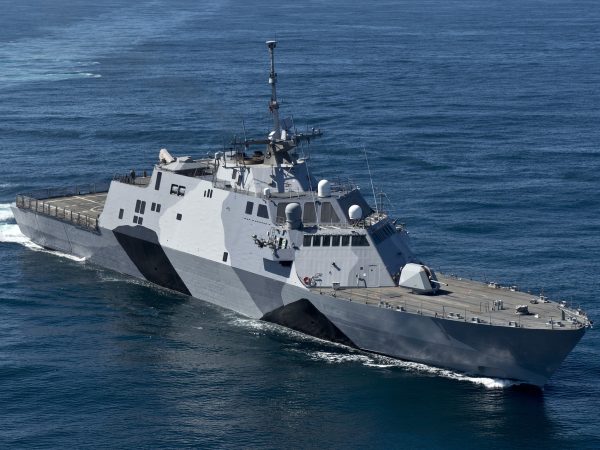Copyright Naked Capitalism

For more than a century, the United States has projected power abroad through naval presence. A cruiser anchored offshore was once enough to send a message: comply or face consequences. The strategy of gunboat diplomacy rested on overwhelming naval superiority, rapid deployment, and the expectation that smaller states would lack the means to resist. But times have changed. The Littoral Combat Ship (LCS), conceived in the early 2000s as a sleek, fast instrument of military force in contested littoral waters, is now being quietly retired. Its failure is more than a procurement fiasco. It marks the end of an era in which the U.S. Navy could sail close to another nation’s coast and expect submission rather than defiance. This article explains the convergent failures of the LCS program and the associated coercive diplomacy concept. A Solution for a Misconceived Mission The LCS was intended to fill a perceived operational gap between large surface combatants and smaller patrol craft. It was to project U.S. naval power in the shallow, congested waters of coastal zones where larger ships would be vulnerable, and to do so quickly, flexibly, and with minimal crew. Two distinct classes were developed, Freedom-class and Independence-class, featuring high speeds (40+ knots), modular mission packages, and minimal armament. Unfortunately, this combination proved fatally flawed. The mission modules never matured as promised. Mechanical failures were frequent and costly. Survivability against modern threats was negligible. The ships were too fragile for high-end combat and too expensive for low-end presence. Two Designs, One Program: A Built-In Vulnerability From its inception, the Littoral Combat Ship program was unusual in that the U.S. Navy approved two entirely different ship designs rather than selecting a single platform. This decision reflected both strategic uncertainty and bureaucratic calculation. Officially, the dual-track approach was framed as a competitive procurement strategy intended to lower costs, encourage innovation, and allow the Navy to “downselect” after real-world testing. The two designs, the Freedom-class littoral combat ship monohull and the Independence-class littoral combat ship trimaran, represented sharply different engineering philosophies. Beneath this rationale lay deeper currents. The Navy did not have a clear concept of operations for littoral warfare in the early 2000s, so authorizing two designs functioned as a hedge against strategic uncertainty. Political considerations were equally important. Two shipbuilders, Fincantieri Marinette Marine and Austal USA, meant more congressional support, more distributed jobs, and greater resistance to cancellation. In theory, the Navy planned to select a single design after operational testing. In practice, it never made that choice. Both designs entered serial production, creating a fractured fleet with incompatible maintenance and training pipelines, duplicative logistics chains, and ballooning lifecycle costs. This dual-design structure magnified every other shortcoming of the program and is now widely recognized as one of its original strategic errors. The Death of Gunboat Diplomacy Gunboat diplomacy once worked because great powers had ships capable of threatening coastal states with impunity. But the proliferation of Anti-Access/Area Denial (A2/AD) military technology has overturned this dynamic. Land-based systems such as the Chinese-made C-802 anti-ship missile can strike naval targets in the littoral area. Ballistic and cruise anti-ship missiles like DF-21D extend denial zones hundreds of miles offshore. Loitering munitions and UAV swarms provide persistent surveillance and strike capability. Advanced air defense and electronic warfare systems make littoral penetration risky even against states lacking a traditional navy. The LCS is poorly suited to the modern threat environment. Designed for speed and flexibility, it is lightly armed, minimally protected, and dependent on modules that never delivered promised capabilities. In any contested littoral, such as the Persian Gulf, the South China Sea, or the Caribbean, it would face layered threats from land-based missiles, UAVs, and submarines. This technological shift means deploying a U.S. naval presence is no longer a cheap, low-risk form of coercion; it is an expensive potential liability. Convergent Failures: Program Development and Foreign Policy Strategy The Littoral Combat Ship program failed not because of a single misstep, but because of a convergence of flawed procurement practices and outdated foreign policy assumptions. On the procurement side, the program was shaped by a belief that naval power projection would remain largely uncontested in the world’s littorals. The resulting ships prioritized speed, modularity, and cost-efficiency over combat effectiveness, survivability, and lethality. Engineering compromises were made in the expectation that advanced mission modules would offset the lack of organic capability, an expectation that never materialized. Meanwhile, U.S. foreign policy strategy continued to rely on the logic of gunboat diplomacy, assuming that the visible presence of U.S. warships would translate into political leverage. This strategic posture was formulated in an era of unipolar dominance and persisted even as the global environment shifted. While the Navy was building fragile, specialized vessels optimized for permissive operations, potential adversaries were acquiring advanced Anti-Access/Area Denial systems, precision strike capabilities, and unmanned platforms capable of threatening U.S. surface ships at low cost. These two failures reinforced one another. A platform poorly designed to enforce an outdated strategy entered service in an era where that strategy no longer worked. As a result, the LCS was not merely a procurement failure; it became a strategic anachronism, emblematic of how procurement dysfunction, institutional inertia, and geopolitical complacency can produce weapon systems that are obsolete the moment they enter service. Venezuela and the Limits of U.S. Naval Coercion The Trump administration has been developing a military strategy aimed at toppling the Maduro regime. A hypothetical U.S. naval coercion campaign against Venezuela would have been straightforward in 1990, but not today. Venezuela does not have a blue-water navy capable of challenging the U.S. fleet, but it does not need one. Its arsenal of shore-based missiles, air defenses, and surveillance systems creates a denial zone that would make operations by lightly armed ships like the LCS perilous. Even a large U.S. naval force would encounter significant resistance from Venezuela. This shift is not unique to Venezuela. Dozens of mid- and small-sized states now possess advanced precision weapons and integrated defense networks. Deterrence, once the preserve of great powers, has been democratized. The assumption that U.S. ships can operate freely off foreign shores is no longer credible. Precision missile proliferation lowers the cost of effective deterrence. Unmanned systems provide surveillance and strike capability without expensive fleets. Electronic warfare and radar coverage erode U.S. advantages in early warning and maneuver. The LCS program failure reflects this new reality: the littoral waters are no longer uncontested. The Yemen Missile Campaign: Proof of Failed Gunboat Diplomacy If the Littoral Combat Ship program represents the conceptual failure of gunboat diplomacy, the Yemen missile campaign represents its operational collapse. Since late 2023, U.S. and allied naval forces have maintained a powerful presence in the Red Sea, deploying advanced surface combatants and carrier strike groups to deter and defeat attacks on international shipping. Yet despite overwhelming firepower, air cover, and persistent surveillance, the campaign by Ansar Allah has continued largely unabated. Yemen is not a great power. It does not field a blue-water navy. Its forces rely primarily on mobile launchers, anti-ship cruise missiles, and UAVs, many of which are inexpensive or supplied through external networks. These weapons, dispersed and concealed, have allowed a weak actor to disrupt global shipping lanes in defiance of the U.S. Navy’s forward presence. This situation lays bare the new strategic landscape: Naval presence no longer guarantees coercive control. Modern shore-based strike systems can outlast, outmaneuver, and outprice traditional deployments. A single missile battery costs a fraction of a U.S. destroyer and can threaten it just the same. This asymmetry is what gunboat diplomacy cannot survive. The Red Sea campaign has made visible what LCS made inevitable: the age of intimidation by offshore warships is over. Acknowledging LCS Failure The U.S. Navy has quietly acknowledged the failure of the Littoral Combat Ship (LCS) program. Although originally intended to produce a fleet of more than 50 vessels, actual operational utility proved so limited that by the mid-2020s, many of these ships were slated for early retirement—some with fewer than 10 years of service. Senior Navy leadership testified before Congress and admitted that the ships could not survive in a contested environment. Budget justification documents shifted resources away from LCS modernization and toward more capable frigate and destroyer programs. Mission modules, once a central innovation, were effectively abandoned after repeated cost overruns and technical failures. The Navy’s 30-year shipbuilding plan reclassified the majority of LCS hulls as non-combatant or auxiliary assets. Several LCS hulls have been decommissioned early and placed in reserve or used for parts reclamation. Others have been offered to foreign allies for transfer or training purposes. A few are being retained for low-intensity missions such as counter-narcotics patrols in permissive environments. Conclusion The LCS is more than a failed warship program. It is a monument to strategic complacency: a vessel designed for a world that no longer exists. The early retirement of LCS ships is an acknowledgment that the era of easy naval coercion is over. Gunboat diplomacy depended on overwhelming, cheap, and credible force projection. That calculus is dead. Precision weaponry has leveled the field. Future U.S. maritime strategy must recognize that naval power projection cannot be taken for granted. The next time a U.S. administration deploys warships to “send a message,” it risks receiving an unpleasant response.



